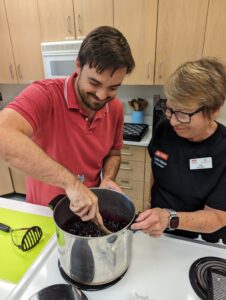Jamming at the Extension Kitchen
go.ncsu.edu/readext?959831
en Español / em Português
El inglés es el idioma de control de esta página. En la medida en que haya algún conflicto entre la traducción al inglés y la traducción, el inglés prevalece.
Al hacer clic en el enlace de traducción se activa un servicio de traducción gratuito para convertir la página al español. Al igual que con cualquier traducción por Internet, la conversión no es sensible al contexto y puede que no traduzca el texto en su significado original. NC State Extension no garantiza la exactitud del texto traducido. Por favor, tenga en cuenta que algunas aplicaciones y/o servicios pueden no funcionar como se espera cuando se traducen.
Português
Inglês é o idioma de controle desta página. Na medida que haja algum conflito entre o texto original em Inglês e a tradução, o Inglês prevalece.
Ao clicar no link de tradução, um serviço gratuito de tradução será ativado para converter a página para o Português. Como em qualquer tradução pela internet, a conversão não é sensivel ao contexto e pode não ocorrer a tradução para o significado orginal. O serviço de Extensão da Carolina do Norte (NC State Extension) não garante a exatidão do texto traduzido. Por favor, observe que algumas funções ou serviços podem não funcionar como esperado após a tradução.
English
English is the controlling language of this page. To the extent there is any conflict between the English text and the translation, English controls.
Clicking on the translation link activates a free translation service to convert the page to Spanish. As with any Internet translation, the conversion is not context-sensitive and may not translate the text to its original meaning. NC State Extension does not guarantee the accuracy of the translated text. Please note that some applications and/or services may not function as expected when translated.
Collapse ▲Our Extension Master Food Volunteers (EMFV) were recently in the Brunswick County Extension demonstration kitchen. They were assisting Family and Consumer Science Extension Agent, Avery Ashley prepare for upcoming jam and preserves classes.
If you’ve never done it before, making a jam is a good first project for a home food
preserver. Jams are thick, sweet spreads made by cooking crushed or chopped fruits with sugar. To get the proper texture, jams require fruit, sugar, pectin and acid in the right combination.
Pectin is the substance in fruits that forms the gel. Pectin is naturally found in some
fruits such as apples, crab apples and some plums and grapes. Other fruits contain little pectin, when this is the case, a commercial pectin product is usually added.
The proper level of acidity is also critical to gel formation. If there is too little acid, the gel will never set. If there is too much acid, the gel will get “weepy” and watery. For fruits low in acid, lemon juice is usually added. Commercial pectin products contain acids which help to ensure gelling.
Sugar is the preserving agent and adds to the gel. It also helps give jams their sweet taste. Cane and beet sugar are the usual sources of sugar for jam. Corn syrup and honey may be used to replace part of the sugar in recipes, but too much will mask the fruit flavor and alter the gel structure. Use tested recipes for replacing sugar with honey and corn syrup.
Many people are looking to make a jam product that has less sugar. You can’t just cut down on the amount of sugar in a traditional recipe. Too little sugar prevents gelling and may allow yeasts and molds to grow. There are special products and recipes that can be used to reduce or omit sugar. These contain modified pectin and gelatins or gums to make the jell.
Many of us remember jams that our grandmas made that had wax or paraffin on the top. Because of possible mold contamination, this method of sealing is no longer recommended. To prevent growth of molds and loss of good flavor or color, modern recipes instruct jams be put in sterilized jars, sealed with self-sealing lids and processed in a boiling water bath.
The EMFVs made blueberry jam from frozen berries. They carefully followed a recipe from So Easy to Preserve, a food preservation recipe and instruction book by the University of Georgia Cooperative Extension Service. Although blueberries are not typically high in natural pectin, the jam the EMFVs made did not have added pectin or acid. This recipe required constant stirring and watching the thermometer while cooking until the mixture reached the jelling point of 220 degrees F. The hot jam was ladled into hot sterilized jars and boiling water bath processed for five minutes.
Instructions for making jams and other fruit preserves can be found online at the
National Center for Home Food Preservation. This Center is based at the University of Georgia (NCHFP.uga.edu) and is our best recommended source for current research-based home food preservation.
Locally, if you have questions about making jam or other food preservation, contact
Avery Ashley at the N.C. Cooperative Extension’s Brunswick County Center at
arashley@ncsu.edu or by calling 910-253-2594. Ask to be placed on the food preservation mailing list. Plans for future classes include dehydration, fermentation and pressure canning.
Ashley has an upcoming class on Fermentation and Sauerkraut scheduled for October 19 at 5:30 p.m. at the Rourk Library in Shallotte. Contact the library for registration information. Pre-registration is required and space is limited. Each participant will make their own jar of sauerkraut.
Syracuse is a Family and Consumer Science team member and can be reached at N.C. Cooperative Extension, Brunswick County Center 910-253-2610 or by email at
Cheryle_Syracuse@ncsu.edu






